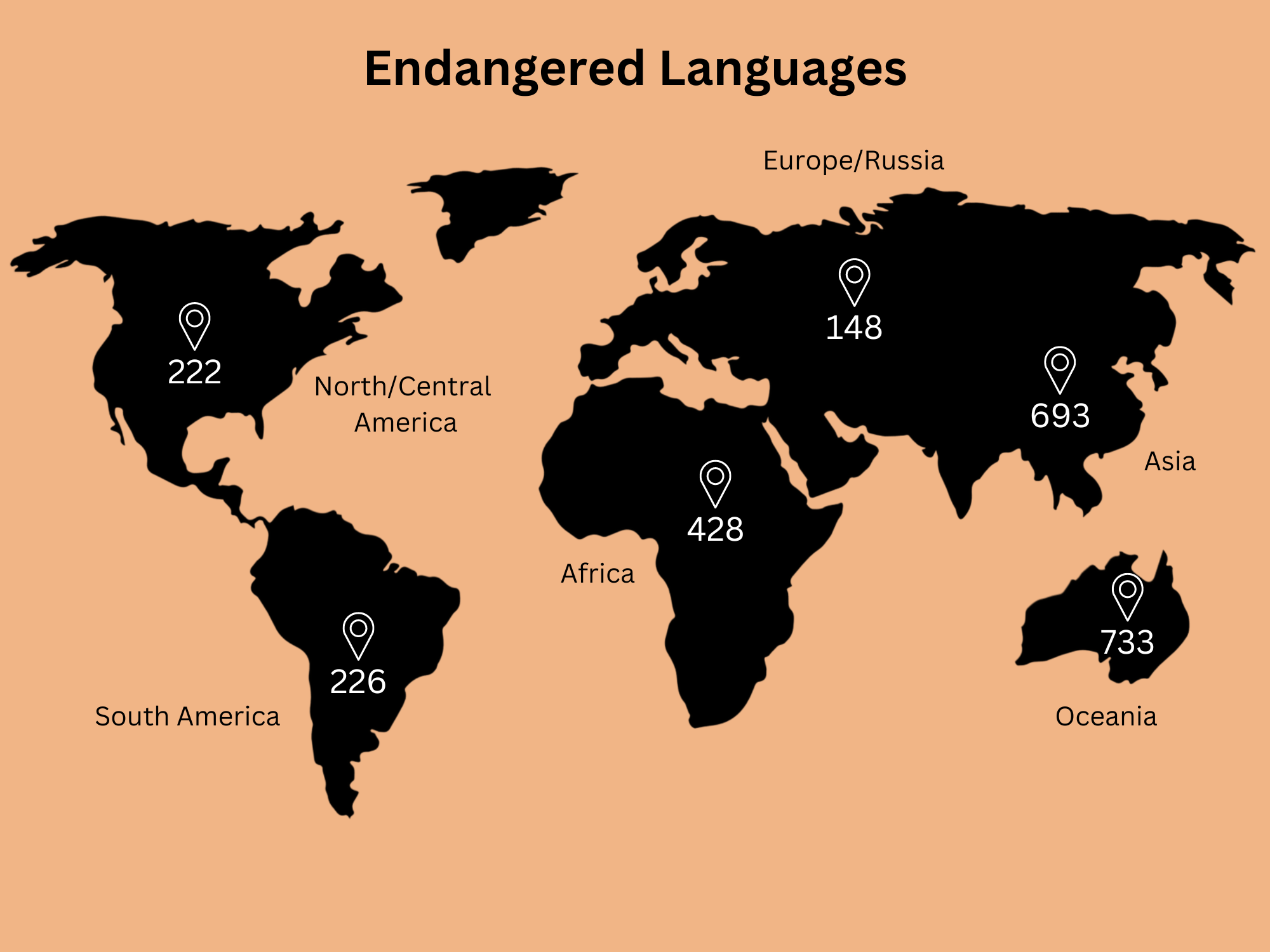Endangered languages and the importance of preservation

There are about 7,000 languages spoken worldwide today. However, more than 2,000 languages are now considered endangered.
In early 2022, data released by the Endangered Languages Project showed there were 222 endangered/threatened languages in North/Central American countries, 226 in South American countries, 148 in Europe/Russia, 428 in Africa, 693 in Asia, and 733 in the Oceania countries.

There are several contributing factors as to why a language becomes endangered including war and genocide; natural disasters, famine, and disease; political repression; urbanization; and intermarriage.
But what are the criteria for a language to be deemed endangered?
According to the United Nations Educational, Scientific and Cultural Organization (UNESCO), there are varying degrees of endangerment. These are separated into categories:
- Extinct – There exists no speaker of the language.
- Critically endangered – The language is used mostly by very few speakers, of the great-grandparental generation.
- Severely endangered – The language is used mostly by the grandparental generation and up.
- Definitely endangered – The language is used mostly by the parental generation and up.
- Unsafe – The language is used by some children in all domains; it is used by all children in limited domains.
- Safe – The language is used by all ages.
The Guardian published a list of languages on UNESCO’s scale of endangerment. Here are some of the languages that are considered “critically endangered”:
• Hawaiian – This is a Polynesian language of the Austronesian language family that takes its name from Hawaiʻi, the largest island in the tropical North Pacific archipelago where it developed.
• Mayo – This is a Uto-Aztecan language. The language is spoken by less than 40,000 people, the Mexican Mayo or Yoreme Indians, who live in the South of the Mexican state of Sonora and in the North of the neighboring state of Sinaloa.
• Yakkha – This is a language spoken in parts of Nepal, the Darjeeling district, and Sikkim. The Yakkha-speaking villages are located to the East of the Arun River, in the southern part of the Sankhuwasabha district, and in the northern part of the Dhankuta district of Nepal.
• Northern Totonac – This is a Totonacan language cluster of Mexico, spoken across a number of central Mexican states by the Totonac people.
• Mūöt/Nancoury – This is a Nicobarese language spoken in the central Nicobar Islands. It is not mutually intelligible with the other Central Nicobarese languages and is distantly related to Vietnamese and Khmer.
• Nihali – This is a moribund language isolate that is spoken in west-central India, with approximately 2,000 people in 1991 out of an ethnic population of 5,000.
• Tchumbuli – A Guang language spoken by 2,000 to 3,000 people in Benin.
• Lanoh – This language is also known by the alternative name Jengjeng, and is an endangered aboriginal Aslian language spoken in Perak, a state of western Malaysia.
• Chuj (Mexico) – A Mayan language spoken by around 3,000 members in Mexico.
• Lokono (Guyana) – This is a Northern Arawakan language spoken in the peri-coastal areas of the Guianas (Guyana, Suriname, French Guiana). Today, in every Lokono village there remains only a small number of elderly native speakers.
• Saaroa – A Southern Tsouic language that is spoken by the Saaroa people, an indigenous people of Taiwan. It is a Formosan language of the Austronesian family.
• Talodi – A Niger-Congo language in the Talodi family of Kordofan, Sudan. Talodi is spoken in Tasomi and Tata villages.
• Xinca – A small extinct family of Mesoamerican languages, formerly regarded as a single language isolate, once spoken by the indigenous Xinca people in southeastern Guatemala, much of El Salvador, and parts of Honduras.
• Itzá – A Mayan language that is spoken by the Itza people near Lake Peten Itza in north-central Guatemala and neighboring Belize.
• Hértevin – A dialect of Northeastern Neo-Aramaic originally spoken by Chaldean Catholics in a cluster of villages in Siirt Province in southeastern Turkey.
• Ulch/Olcha – A Tungusic language spoken by the Ulch people in the Russian Far East.
• Iñapari – This is an indigenous South American language spoken by just four people in Perú along the Las Piedras River near the mouth of the Sabaluyoq river.
• Ottawa (Michigan) – This language is also known as the Odawa dialect of the Ojibwe language is spoken by the Ottawa people in southern Ontario in Canada, and northern Michigan in the United States.
• Northern Paiute (Oregon) – A member of the Uto-Aztecan language family. It is most closely related to the language of the Owens Valley Paiute and to Mono, spoken directly on the other side of the Sierra Nevada.
• Tlingit (United States of America) – The language of coastal Southeastern Alaska from Yakutat south to Ketchikan. The total Tlingit population in Alaska is about 10,000 in 16 communities with about 500 speakers of the language.
• Sauk-Fox – An Algonquian language, spoken by a thousand Meskwaki, Sauk, and Kickapoo in various locations in the Midwestern United States and in northern Mexico.
• Zazao – An Oceanic language spoken in the Solomon Islands. Its speakers live on Santa Isabel Island.
• Assiniboine (Canada) – A Nakotan Siouan language of the Northern Plains. The name Assiniboine comes from the term Asiniibwaan, from Ojibwe, meaning “Stone Siouans”.
Of course, this is just a small number of languages on UNESCO’s list.
But many organizations are helping to preserve endangered languages. Besides the Endangered Language Project, other groups involved in revitalization projects include Living Tongues Institute for Endangered Languages, Committee on Endangered Languages and Their Preservation (CELP), The Endangered Language Fund, Endangered Language Alliance, and many others.
But what is the importance of saving languages? When a language becomes extinct, a culture can be lost. Language is entrenched in a community – its stories, songs, poems, and heritage.

Ways individuals can help preserve endangered languages range from keeping and maintaining printed or written documentation of a language to promoting languages on social media, taking language courses, and teaching languages to children and others.
Teneo Linguistics Company has thousands of professional, experienced linguists in its database who are proficient in more than 180 languages. And the languages TLC offers continue to grow over time.
Learn more about how TLC can support language projects by visiting www.tlctranslation.com.






